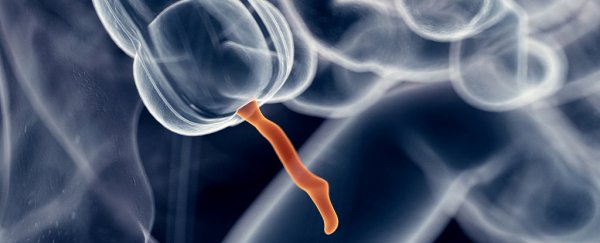An analysis of around 1.7 million people has revealed a curious link between the appendix and Parkinson's disease.
The study found that people who'd had the little nub of tissue removed were up to 25 percent less likely to develop Parkinson's disease, depending on where they lived.
Not only that, but clumps of protein previously associated with the condition were discovered in the appendix and other parts of the digestive system, adding to existing evidence linking the gut with brain disease.
Neuroscientists from research bodies around the world combined details from the Parkinson's Progression Markers Initiative with records in the nationwide Swedish National Patient Registry to search for a relationship between the neurodegenerative disease and appendectomies.
The comparison wasn't a mere stab in the dark – there's a growing pool of evidence suggesting for many people, Parkinson's disease starts down below in the gut and travels up the vagus nerve into the brain.
This might not be as surprising as first thought, given an early symptom of the condition is constipation. Abnormal clumps of a protein called alpha-synuclein associated with the disease have also been spotted in GI tracts.
Since the protein accumulates as an immune reaction to toxins and bacteria, and the intestinal cul-de-sac called the vermiform appendix is thought to have a role to play as a bomb shelter for gut microflora, it's an obvious place to go digging for a connection.
"Despite having a reputation as largely unnecessary, the appendix actually plays a major part in our immune systems, in regulating the makeup of our gut bacteria and now, as shown by our work, in Parkinson's disease," senior author Viviane Labrie from Van Andel Research Institute in Michigan told The Guardian.
These aren't the first researchers to go looking, either. Other studies have had mixed results.
Parkinson's is a slow acting disease. It takes years for dopamine-producing brain cells to degrade to the point where the body experiences tremors, muscle rigidity, and loss of various automatic movements.
This slow death of brain cells appears to be related to the way alpha-synuclein folds and clumps in some people, which to some degree is blamed on mutations in the gene responsible for the protein's construction.
But decades of research suggest there has to be more to this accumulation than genes alone, with interactions between the brain and gut looking increasingly suspicious.
The slow pace of Parkinson's onset is no doubt preferable to those at risk, but for researchers it makes its study a little more difficult.
By making use of a long-term patient registry, the team could reach back decades to see who had their appendix removed and see whether they had since received a Parkinson's diagnosis.
A comparison of figures in those two databanks confirmed something odd is going on.
More than half a million of patients in the registry had received appendectomies due to suspected inflammation or infection, while around 2,200 of the 1.7 million patients had been diagnosed with Parkinson's disease.
The overlap was telling, with just 1.6 diagnoses per 100,000 people being found in those without an appendix. Among those who still had their appendix intact, the rate was closer to 2.0 per 100,000.
The jump of 20 percent is significant, but this shouldn't be taken to mean getting your appendix whipped out will make you immune to Parkinson's disease.
It does add yet another element to the mystery, helping researchers better understand why mutant forms of alpha-synuclein accumulate and kills brain cells.
Comparisons based on whether patients lived in urban or rural settings also found that country folk who had their appendix removed were 25 percent less likely to develop the disease. This contributes to previous research showing links between pesticide exposure and Parkinson's disease.
Future research could tell us exactly how an immune response in the gut kicks off cell-murdering clumps of protein in the brain, and potentially help slow or even prevent the onset of a disease.
This research was published in Science Translational Medicine.
